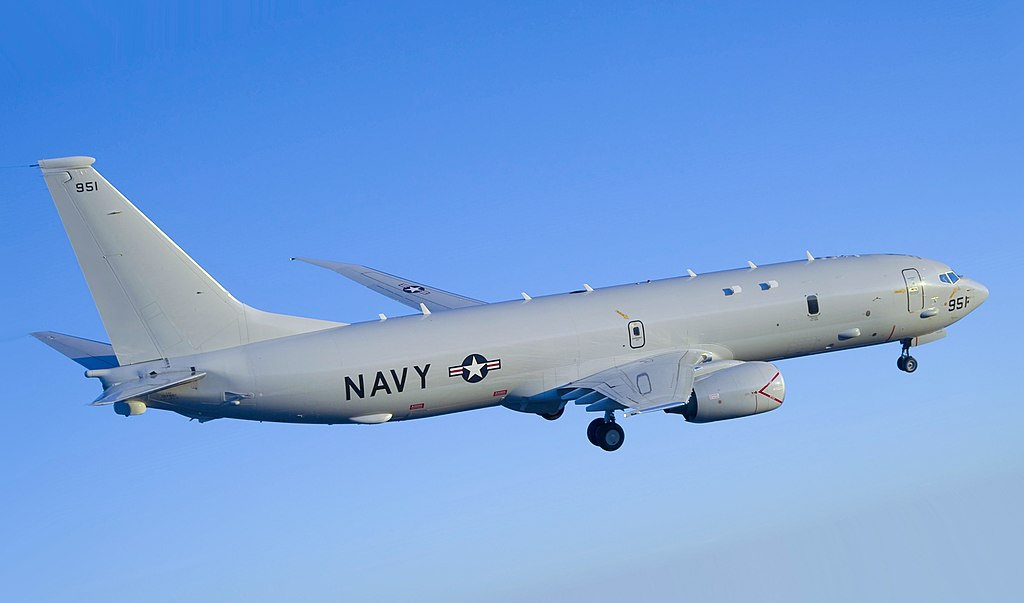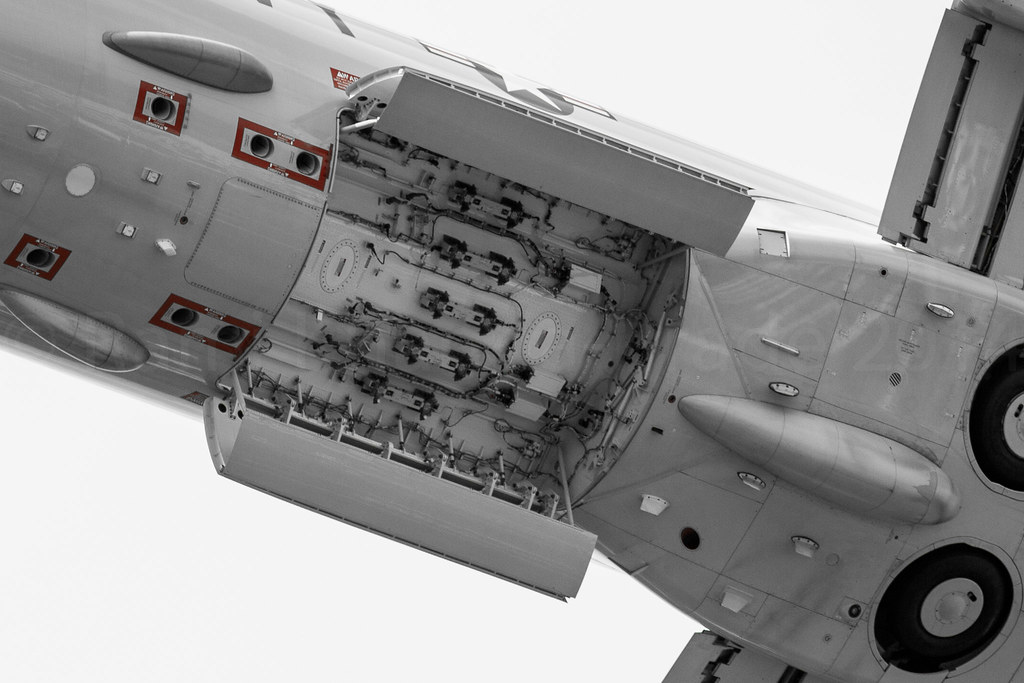The Boeing P-8 Poseidon (formerly the Multimission Maritime Aircraft or MMA) is a military aircraft developed for the United States Navy (USN). The aircraft has been developed by Boeing Defense, Space & Security, modified from the 737-800ERX.
The P-8A Poseidon is an aircraft designed for long-range anti-submarine warfare; anti-surface warfare; and intelligence, surveillance and reconnaissance missions.
It is capable of broad-area maritime and littoral operations. It is designed to operate in conjunction with the Northrop Grumman MQ-4C Triton Broad Area Maritime Surveillance unmanned aerial vehicle. The aircraft has been ordered by the Indian Navy as the P-8I Neptune, and the Royal Australian Air Force. The Royal Air Force also intends to order the P-8.
Development
In the 1980s, the Navy began studies for a P-3 replacement, the range and endurance of which was reducing due to increasing weight and airframe fatigue life limitations. The specification required a new aircraft to have reduced operating and support costs. In 1989, the Navy awarded Lockheed a fixed-price contract to develop the P-7, but this was canceled the following year.A second competition for a replacement began in 2000. Lockheed Martin submitted the Orion 21, an updated new-build version of the P-3. Boeing's proposal was based on its 737-800 airliner. BAE Systems offered a new-build version of the Nimrod MRA4, a British jet-powered maritime patrol aircraft. BAE withdrew from the competition in October 2002, recognizing that without a production partner based in the United States, the bid was politically unrealistic. On 14 May 2004, Boeing was selected as the winner.
In June 2004, the US Navy announced the selection of the Boeing multimission maritime aircraft, 737 MMA, and awarded a contract to Boeing for the system development and demonstration phase of the programme for the US Navy's next-generation maritime surveillance aircraft.The project was planned to be for at least 108 airframes for the Navy. More orders are possible from the other nations operating over 200 P-3s. Project value is expected to be worth at least $15 billion. Raytheon, Northrop Grumman, Spirit AeroSystems, GE Aviation Systems, Marshall Aerospace and Defence Group, CFMI, BAE Systems, and Marotta are major subcontractors. In July 2004, the Navy placed an order for five MMA aircraft, and the first flight-test aircraft was to be completed in 2009. The aircraft was given the designation P-8A in March 2005.
The preliminary design review (PDR) was successfully completed in November 2005. The critical design review was completed in July 2007. Boeing began production of the first of five test aircraft in December 2007. The first flight of the P-8A test aircraft T1 was completed in April 2009. The first mission systems test flight of the T2 was successfully completed in June 2010. The test aircraft T3 completed its first flight test in July 2010.
Full-scale static testing on the airframe of the first ground-test vehicle S1 was completed in January 2011. The fatigue tests on S2, the second ground-test vehicle, began in late 2011. The first P-8A production aircraft completed its maiden flight in July 2011.
It is expected that up to 117 P-8A MMA aircraft are to be purchased by the navy to replace the fleet of 196 P-3C Orion maritime patrol aircraft which are approaching the end of their operational lives. The initial operational capability (IOC) of P-8A was achieved in November 2013.
Design
The aircraft design is based on the proven fuselage of the 737-800 and the wings of the 737-900. The P-8A aircraft has increased gross weight capability in comparison with the 737-800.The fuselage is similar, but longer, than the 737-700-based C-40 Clipper transport aircraft in service with the U.S. Navy. The P-8 has a strengthened fuselage for low-altitude operations and Boeing 767-400ER-style raked wingtips, instead of the blended winglets available on 737NG variants.
The internal weapons bay is installed beneath the forward section of the fuselage. The 737-900-style wings are built with hardpoints for carrying air-to-surface missiles.
The 737 MMA is assembled at the Boeing production facility in Renton, Washington, US. The 737's fuselage and tail sections are built by Spirit AeroSystems in Wichita, Kansas, before being transferred to Renton, where all the unique 737 MMA aircraft structural features are incorporated in sequence during fabrication and assembly.
The quality and performance acceptance flight testing of the aircraft was conducted from Renton Field and final installations and checkout of the mission system and special flight test instrumentation was conducted at the Boeing Field. The aircraft then ferried to naval air station at Patuxent River, Maryland, for flight test.
Cockpit and flight management systems
The flight management system and the stores management system were developed by Smiths Aerospace. The Smiths Aerospace flight management system is based on an integrated open architecture and will be compatible with the installation of future upgrade systems.
The cabin is fitted with up to seven operator consoles.
In March 2008, Boeing selected L-3 Communications Wescam to supply the MX-20HD digital electro-optical and infrared (EO/IR) multispectral sensor turrets for the P-8A Poseidon. MX-20HD is gyro-stabilised and can have up to seven sensors, including infrared, CCDTV, image intensifier, laser rangefinder and laser illuminator.
The aircraft is equipped with the upgraded APS-137D (V) 5 maritime surveillance radar and signal intelligence SIGINT system developed by Raytheon. The system was re-designated AN/APY-10 in June 2006. The AN/APY-10 radar is installed on the enlarged nose fairing.
The AN/APY-10 radar provides the synthetic aperture radar (SAR) mode capability for imaging, detection, classification and identification of stationary ships and small vessels and for coastal and overland surveillance, as well as the high-resolution imaging synthetic aperture radar (ISAR) mode for imaging, detection, classification and tracking of surfaced submarines and small, fast-moving vessels that operate in coastal waters.
The SAR provides multiple-resolution strip map and spot SAR operation, and allows high-resolution for target identification, battle damage assessment and weapons targeting.
Periscope detection uses high-scan speeds, high-pulse repetition frequency and high-resolution mode with advanced sea clutter rejection.
Raytheon is offering the new global positioning system with anti-jam, integrated friend or foe and towed decoy self-protection suites, along with a broadcast information system (BIS) and secure UHF satellite communications.
The P-8A is also fitted with the CAE advanced integrated magnetic anomaly detection (MAD) system. The aircraft carries a rotary sonobuoy launcher with pneumatic ejection, being developed by EDO Corporation. The data links are being developed by Northrop Grumman Information Technology Division in Herndon, Virginia.
Weapons on the multimission maritime aircraft
The integral bomb bay can carry free-fall bombs, Raytheon Mark 54 torpedoes and depth charges. Air-to-surface and air-to air missiles, such as Harpoon anti-ship missiles, SLAM or AGM-65 Maverick land attack missiles, and AIM-9 Sidewinders or AIM-120 AMRAAMs will be carried on the underwing hardpoints.
The US Navy armed the P-8A with a development of the MK 54 torpedo that can be fired from high-altitude. The first MK 54 torpedo was successfully test fired by the P-8A Poseidon in October 2011.
Countermeasures of the P-8A Poseidon
Northrop Grumman is supplying the electronic warfare self-protection (EWSP) suite which includes a Terma AN/ALQ-213(V) electronic warfare management system (EWMS), a Northrop Grumman directional infrared countermeasures (DIRCM) set, a Northrop Grumman radar warning system and a BAE Systems countermeasures dispenser system.
Aircraft performance and engines
The aircraft can cruise at high altitude at nearly 926km/h (500kt) and loiter at a speed of 333km/h (180kt) over the sea at 60m.
The aircraft has two CFM International CFM56-7B27A high-bypass turbofan engines, each rated at 120kN.
The same model CFM56-7 engines power the Boeing 737 airborne early warning and control (AEW&C) aircraft, in production for Australia and Turkey, and the US Navy's C-40 Clipper transport.
The engine has logged more than 30 million flight hours and maintains a proven high-reliability figure of merit of 0.003% in-flight shut down rate for every 1,000 hours of flight.
Additional fuel tanks are installed in the aft baggage hold, providing a total maximum fuel capacity of 34,096kg.
Variants
P-8A Poseidon – Production variant for the U.S. Navy
P-8I Neptune – Export variant for the Indian Navy.
P-8 AGS – An Airborne Ground Surveillance variant proposed to the United States Air Force in 2010 as an alternate to upgrades to the Northrop Grumman E-8 Joint STARS fleet. Its design adds a pod-mounted, active electronically scanned array (AESA) radar on the bottom of the fuselage.
P-8 Technical Specifications
Crew: Flight: two; Mission: seven
Length: 129 ft 5 in (39.47 m)
Wingspan: 123 ft 6 in (37.64 m)
Height: 42 ft 1 in (12.83 m)
Empty weight: 138,300 lb (62,730 kg)
Useful load: 19,800+ lb (9,000+ kg)
Max. takeoff weight: 189,200 lb (85,820 kg)
Powerplant: 2 × CFM56-7B turbofan, 27,000 lbf (120 kN) each
Performance
Maximum speed: 490 knots (907 km/h, 564 mph)
Cruise speed: 440 kn (815 km/h, 509 mph)
Combat radius: 1,200 nmi (2,222 km) ; 4 hours on station (for anti-submarine warfare mission)
Ferry range: 4,500 nautical miles (8,300 km)
Service ceiling: 41,000 ft (12,496 m)
Armament
5 internal and 6 external stations for AGM-84H/K SLAM-ER, AGM-84 Harpoon, Mark 54 torpedo, missiles, mines, torpedoes, bombs, and a High Altitude Anti-Submarine Warfare Weapon system
Avionics
Raytheon APY-10 multi-mission surface search radar
(Advanced Airborne Sensor surface search radar and SIGINT package to be follow on system)



